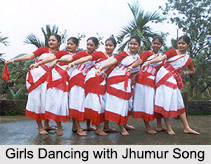 Jhumur Song is a kind of folk song of the ancient tradition. Earlier, Jhumur was the song of indigenous communities, especially the Santals; it is still very popular among them. Jhumur dance and songs are performed in a group. The Santals perform Jhumur dance and song on the occasion of Karam festival. Because of the charm of this style, Jhumur song has become popular among the common people of this region. Baru Chandidas`s love story of Shri Krishna-kirtan is also influenced by the popular Jhumur and Dhamali songs.
Jhumur Song is a kind of folk song of the ancient tradition. Earlier, Jhumur was the song of indigenous communities, especially the Santals; it is still very popular among them. Jhumur dance and songs are performed in a group. The Santals perform Jhumur dance and song on the occasion of Karam festival. Because of the charm of this style, Jhumur song has become popular among the common people of this region. Baru Chandidas`s love story of Shri Krishna-kirtan is also influenced by the popular Jhumur and Dhamali songs.
History of Jhumur Song
Vaishnavism was adopted by the Malla Raj and his feudatories of Bankura, Jhargram, Midnapore and Purulia. Since then, Padavali began to spread among the tribal people and they were influenced by their ideas and musical qualities. Then they composed a new class of lyric songs in Bengali named Jhumur on the basis of their own music, dance and song. Soon it became a class by itself, which was folk and un-orthodox in character.
Characteristics of Jhumur Song
One of the characteristics of Jhumur song is establishing relationship between two characters and then to set up dialogues between them. Such dialogues are also in Shri Krishna-kirtan among Radha, Krishna and Bodai. Main two features of Jhumur songs are first it goes up to crescendo and then gradually descends down to diminuendo. And then it becomes stable in the lowest foot in its musical harmony. Secondly, in this singing tradition, the balance between crescendo and the base note remains unchanged. The songs were composed by the bi-lingual tribal as well as Bengali speaking local people on the eternal theme of love of Radha and Lord Krishna.
Jhumur Song as the Background of Chhau Dance
Chhau dance in its present form is associated with the introduction of Jhumur songs. Now-a-days no Chhau dance is possible without Jhumur. The people who sing Jhumur during Chhau dance are bi-lingual or they speak Bengali besides their own tribal mother-tongue. Though they cannot speak Bengali properly yet they do not sacrifice this practice of introducing each item of dance by a Jhumur. This is one of the folk elements which is attached to Chhau dance of Purulia. However it is not known whether during the period of patronage of the local feudal chiefs, music in classical style used to be sung at the background of the dance.
Jhumur is also sung in the course of a solo dance performed by a class of professional dancing girls known as nachni or Khemti. Such songs are also based on the divine love of Radha and Krishna and the sublime character of the theme is maintained.
Composers of Jhumur Songs
The Jhumur songs are composed by the members of the scheduled tribes and scheduled castes and at times by Hindus also. Most of the songs are still composed on the love episode of Radha and Krishna. A spirit of sublimity of divine love is maintained in most of the songs composed, though they represent a form of folk-songs of Bengal.
Jhumur Songs in Vaishvava Pada
Jhumur songs are also mentioned in Vaishvava Pada, for example- Shyam (Krishna) is singing Jhumur by playing flute; a stanza of Padokalpataru contains- a host of young women singing Jhumur song. Although the tradition of Vaishnava songs are followed in ordinary, non-religious Jhumur songs, its singing style is different.
Performing Style of Jhumur
Jhumur is mostly performed in open places. The male performers wear long traditional dresses and keep the rhythm with few traditional instruments- generally a drum, hung on shoulder; a flute and a pair of "Taal" (two metallic discs). The girl performers mostly perform Jhumur, holding each other`s waist and moving hands and legs forward and backward synchronously.
Types of Jhumur Songs
Jhumur songs are performed on different occasions, such as Santali Jhumur dance and song are performed on the occasion of Karam festival; Darshali and Chhau Jhumur dance and song are performed on the occasion of Darshal in Purulia and for Chhau dance. Khemta Jhumur song is performed with Khemta dance; and in the month of Bhadra, Bhaduria Jhumur song is performed to eulogize nature. To establish a bond of friendship between man and woman, there is a tradition of performing Pata Jhumur song, which is accompanied by dance.
Examples of Jhumur Songs
From various Jhumur songs, some popular are Ganthibo Fuler-i Mala, Ami Ghuchaibo Moner Jwala, Bandhu! Hridoi Majare Shyamke Rakhibo Adore, Na Aile Nandalal Kemone Mitabo Jwala, Thak Thak Pranboleov Bandha Prem-Dore, Hridoi Mondire Shyamke Rakhibo Adorey etc.




















